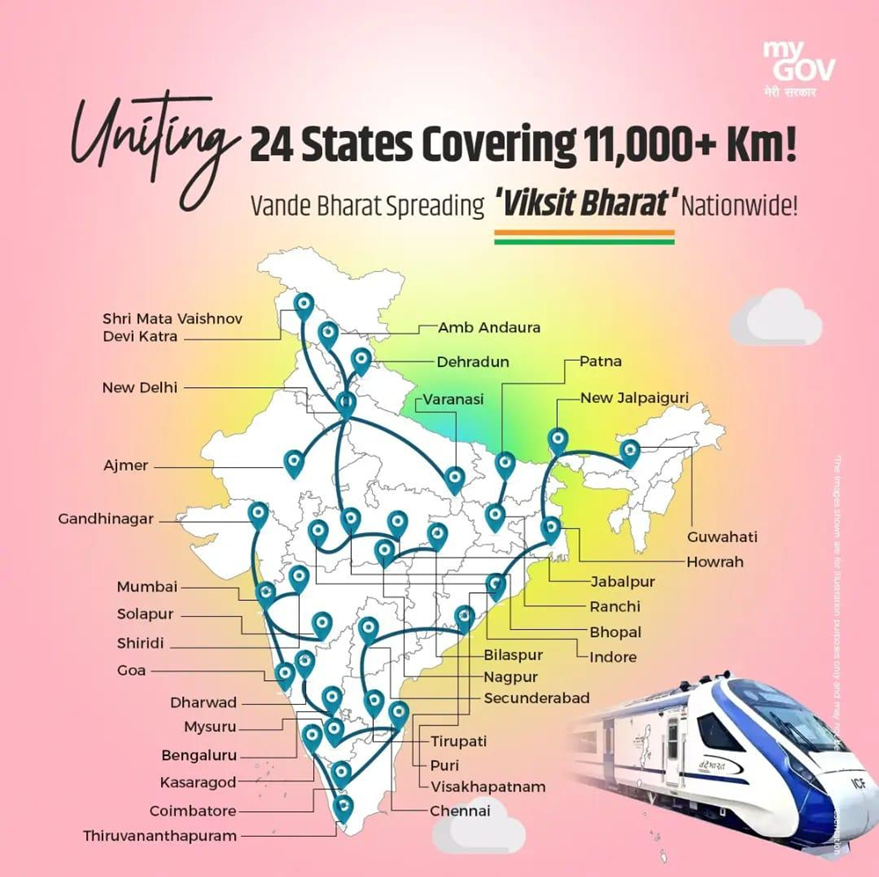GET THE VANDE METRO ROUTING RIGHT
Relevance: GS – 3 – Indian Economy and issues relating to planning, mobilization, of resources, growth, development and employment.
Why in the News?
- The Vande Bharat trains have captured India’s imagination.
- Out of the 51 origin-destination (O-D) pairings with 82 Vande Bharat rakes introduced by Indian Railways (IR), at least 10 O-D pairs have very low patronage.
- The Indian Railways recovers only 47 paisa for every rupee spent on passenger services, leading to significant financial strain.
- There was no scientific identification of O-D pairs to ensure high patronage on all routes before the introduction of the Vande Bharat trains.
- Rough estimates suggest the Indian Railways is losing about ₹100 crore due to poor patronage of some Vande Bharat O-D pairs.
Vande Metro Trains
- The first Vande Metro prototype rake, with 12 coaches and passenger facilities comparable to Vande Bharat trains, was produced by the Rail Coach Factory in Kapurthala, Punjab.
- These trains are designed to run up to 250 kilometres between major cities and neighbouring towns.
- While selecting O-D pairs for the Vande Metro trains, the Railways should avoid repeating the errors made during the selection of O-D pairs for the Vande Bharat trains.
- Comparison with Road Travel
- National Highways are developed to connect major cities with smaller towns.
- Buses: Buses for distances up to 250 km are generally not luxury buses (such as Volvo and Scania), leading to a lower quality of ride.
- Car Travel: Provides Average Speed about 90 kmph. Also not affordable for middle-class passengers.
Categories of Train Services
Express/Mail Trains
- Stops in major towns en route.
- Designed for efficient travel between significant locations.
Ordinary Trains
- Slow-moving, multi-stop passenger trains.
- Numerous stops along the route.
- Provides service to smaller towns and localities.
Electric Multiple Unit/Mainline Electric Multiple Unit (EMU/MEMU)
- Also Known as Local trains.
- Numerous stops to connect major cities with suburbs and farther out.
- Passenger Experience crush loading during peak hours.
Vande Metro – the Travel Gamechanger
- Design and Features: Continuous, Fully Air-Conditioned Gangway: Allows passengers to board and depart from any entrance, travel between coaches, and use the bio-toilets.
- Speed: Maximum design speed of 130 kmph, average speed between 75 kmph and 90 kmph, depending on track and stops.
- Current Pricing:
- Second-class travellers pay 45 paisa/km on mail/express trains.
- 22 paisa/km on ordinary trains.
- 18 paisa/km on EMU/MEMU trains.
- Energy and Cost Considerations:
- Energy Costs: Higher energy costs due to air-conditioning compared to non-air-conditioned second-class carriages.
- Manufacturing Cost:
- Prototype Vande Metro train costs ₹8 crore per coach.
- Bulk production could reduce the cost to ₹6 crore per coach.
- Operational Costs: Higher than second-class suburban coaches.
- Passenger Behavior:
- Behavioral Lock-In: Rail travellers are accustomed to low-cost travel.
- Switch to Vande Metro: Uncertainty if second-class passengers will switch to higher-priced air-conditioned Vande Metro trains.
- Installation of air-conditioning coaches on Mumbai’s suburban rail system has not yielded expected outcomes.
- Better Facilities and Safety:
- Better Facilities: Quicker travel times, more pleasant travel experience, secure boarding and disembarkation, modern lavatory facilities.
- Enhanced Safety: Closed doors prevent fatalities during boarding and disembarking, a common issue with EMU and MEMU trains.
Air-Conditioned Services and Pricing
- Monthly Pass Pricing:
- Non-Air-Conditioned: ₹105 to ₹500.
- Air-Conditioned: ₹650 to ₹3,150.
- Passenger Request and Response:
- High Density: Passengers travel at an extraordinarily high density of 14 people per square metre.
- Introduction of Air-Conditioned Coaches: Responding to passenger requests, air-conditioned coaches were introduced two years ago.
- Adoption and Issues:
- Low Adoption Rate: Only 4% of local train customers switched to air-conditioned coaches in 2023.
- Ticketless Travel: Many without proper tickets began using air-conditioned coaches, causing crowding.
- No Financial Benefit: Neither Indian Railways nor passengers benefited financially due to crowded air-conditioned coaches and waiting times on platforms.
- Comparison with RapidX (Vande Namo):
- Systemic Check-In: RapidX has check-in systems for executive and ordinary classes, unlike local trains.
Lessons for Vande Namo Metro
- Avoid Past Mistakes: Learn from the errors made in selecting O-D pairs for Vande Bharat trains.
- Conduct Demand Analysis: Perform methodical analysis of demand projections for various O-D pairs before route selection.
- Understand Passenger Behavior: Consider the willingness and ability of passengers to pay for air-conditioned services.
- Pricing Strategy: Ensure competitive pricing that balances affordability for passengers and cost recovery for Railways.
- Prevent Overcrowding: Implement measures to prevent ticketless travel and manage crowding in air-conditioned coaches.
- Incorporate Feedback: Use passenger feedback to improve service offerings and meet traveler expectations.
- Leverage Technology: Introduce check-in systems similar to RapidX to manage passenger flow and ticket validation.
- Optimize Operational Costs: Aim for cost-effective manufacturing and operational strategies to keep expenses manageable.
- Enhance Travel Experience: Focus on providing a comfortable, quick, and safe travel experience with modern amenities.
- Maximize Revenue: Strive for high patronage and efficient use of train services to boost revenue for Indian Railways.
Associate articles
https://universalinstitutions.com/urban-mobility-india-conference/
Source: https://www.thehindu.com/opinion/op-ed/get-the-vande-metro-routing-right/article68341444.ece
Mains question
Discuss the challenges and lessons learned from the introduction of Vande Bharat trains in India. Evaluate the importance of passenger behavior understanding in optimizing route selection and pricing strategies. (250 words)




